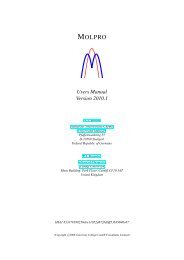Carbon−Carbon Coupling Reactions Catalyzed by Heterogeneous ...
Carbon−Carbon Coupling Reactions Catalyzed by Heterogeneous ...
Carbon−Carbon Coupling Reactions Catalyzed by Heterogeneous ...
You also want an ePaper? Increase the reach of your titles
YUMPU automatically turns print PDFs into web optimized ePapers that Google loves.
<strong>Heterogeneous</strong> Pd <strong>Catalyzed</strong> C−C <strong>Coupling</strong> <strong>Reactions</strong> Chemical Reviews, 2007, Vol. 107, No. 1 147<br />
absorber utilized in the manufacture of sunscreen lotion<br />
(Scheme 20).<br />
Scheme 20. Heck Reaction of 1-Bromo-4-methoxybenzene<br />
with Octyl Acrylate<br />
Köhler et al. provided a very detailed investigation about<br />
the application of Pd/C in the Heck reaction of aryl bromides<br />
with olefins. 28,50 A variety of Pd/C catalysts differing in Pd<br />
dispersion, Pd distribution, Pd oxidation state, and water<br />
content were tested. The experimental results indicated a<br />
(quasi-)homogeneous reaction mechanism, that is, the Pd<br />
complex or colloidal particles in solution act as the catalytically<br />
active species. E 105 CA/W 5% Pd from Degussa AG<br />
turned out to be the best Pd/C catalyst. It has a high Pd<br />
dispersion (36%), a low reduction degree [mainly Pd(II)],<br />
and a high water content (∼55%). Its high catalytic activity<br />
in N-methylpyrrolidone/sodium acetate at 140 °C allowed<br />
working with extremely low catalyst concentrations (Table<br />
28). An argon atmosphere helps to decrease the Pd leaching<br />
while maintaining the high activity. Under these optimized<br />
reaction conditions, turnover numbers (TON) up to 36 000<br />
and turnover frequencies (TOF) up to 18 000 h -1 (for<br />
bromobenzene) were achieved using a Pd concentration as<br />
low as 0.0025 mol % (Table 28, entry 3). Complete<br />
conversion was achieved for activated (electron-withdrawing<br />
substituents) and nonactivated, as well as deactivated,<br />
bromoarenes (electron-donating substituents) within a few<br />
hours. The extraordinarily high activity seems to be connected<br />
with dissolution-reprecipitation processes, where<br />
dissolved Pd species formed at this temperature are the active<br />
species. Much lower catalytic activity (TON and TOF<br />
reduced <strong>by</strong> magnitudes) in Heck coupling was found with<br />
pre-reduced Pd/C catalysts (Table 28, entries 4 and 5) in<br />
accordance with previous findings. 11<br />
Table 28. Effect of Reaction Conditions on the Heck Reaction of<br />
Aryl Bromides with Styrene 81<br />
entry R<br />
catalyst<br />
(mol %) T (h)<br />
yielda conv (%)<br />
(%) 76 77 78 TON TOF<br />
1 Ac 0.005 4 96 90 0 5 19200 4800<br />
2 H 0.005 1 90 83 1 6 18000 18000<br />
3 H 0.0025 2 90 83 1 6 36000 18000<br />
4 b H 1.0 20 58 52 0 5 58 3<br />
5 c H 1.0 20 12 10 0 1 12












![Hetero [6+3] Cycloaddition of Fulvenes with N-Alkylidene Glycine ...](https://img.yumpu.com/35423358/1/190x245/hetero-6-3-cycloaddition-of-fulvenes-with-n-alkylidene-glycine-.jpg?quality=85)




